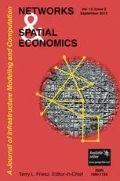Abstract
The pace of changes in automating cars has sped up in the last few decades. Autonomous Vehicles (AVs) will dramatically change the future of transportation, and household-level decisions will play a large role in the AV market. However, no data is readily available on household travel behavior using AVs. This study introduces a framework to assess households’ adaptation to AV operations. We developed a mixed integer program, Household Activity Pattern Problem with AV (HAPPAV), to model traveler behavior under realistic conditions while using AVs. The model generates feasible activity patterns for household members under spatial and temporal constraints. The model is able to consider complete driverless operations, such as AV pick-up and drop-off, parking availability, empty trips, and carpooling. A decomposition method is developed to solve the NP-hard problem HAPPAV. The method includes two major stages; the first stage is to generate all feasible travel patterns for household members and the second stage finds the best AV route along with detailed travel patterns. We also use novel pruning rules to enhance the performance of the decomposition method. The model is applied on the California Statewide Travel Survey. The results indicate that 62% of households can perform their daily activities with only one AV in place of two or three regular vehicles. However, AV empty trips increase total VMT by 15%. The new method improves the average runtime and solution quality by 86% and 23%, respectively.




Similar content being viewed by others
References
Chow JY, Nurumbetova AE (2015) A multi-day activity-based inventory routing model with space–time–needs constraints. Transportmetrica A Transport Sci 11(3):243–269
Chow JY, Recker WW (2012) Inverse optimization with endogenous arrival time constraints to calibrate the household activity pattern problem. Transp Res B Methodol 46(3):463–479
Drexl M (2011) Synchronization in vehicle routinga survey of vrps with multiple synchronization constraints. Technical report, Gutenberg School of Management and Economics Johannes Gutenberg University, Mainz, Germany
Drexl M (2012) Synchronization in vehicle routinga survey of vrps with multiple synchronization constraints. Transp Sci 46(3):297–316
Dumas Y, Desrosiers J, Soumis F (1991) The pickup and delivery problem with time windows. Eur J Oper Res 54(1):7–22
Fagnant DJ, Kockelman K (2015) Preparing a nation for autonomous vehicles: Opportunities, barriers and policy recommendations. Transport Res Part A Policy Pract 77:167–181
Kang JE, Recker W (2013) The location selection problem for the household activity pattern problem. Transport Res Part B Methodol 55:75–97
Kang JE, Recker WW (2014) Measuring the inconvenience of operating an alternative fuel vehicle. Transport Res Part D Transport Environ 27:30–40
Khayati Y, Kang JE (2015) Modeling intra-household interactions for the use of battery electric vehicles. Transportation Research Board 94th Annual Meeting 15–4052
Li T, Kockelman KM (2016) Valuing the safety benefits of connected and automated vehicle technologies. 95th Annual Meeting of the Transportation Research Board, January 2016
Litman T (2015) Autonomous vehicle implementation predictions: Implications for transport planning. 94th Annual Meeting of the Transportation Research Board
Litman T (2017) Transportation cost and benefit analysis ii–travel time costs victoria. BC: Victoria Transport Policy Institute
Liu J, Kang JE, Zhou X, Pendyala R (2018) Network-oriented household activity pattern problem for system optimization. Transport Res Part C Emerg Technol 94:250–269
Monje C, Endorf R (2015) Revised departmental guidance on valuation of travel time in economic analysis US Department of Transportation, Washington, DC
Parragh SN, Doerner KF, Hartl RF (2008) A survey on pickup and delivery problems. Journal für Betriebswirtschaft 58(1):21–51
Pendyala RM, Yamamoto T, Kitamura R (2002) On the formulation of time-space prisms to model constraints on personal activity-travel engagement. Transportation 29(1):73–94
Pinjari AR, Augustin B, Menon N (2013) Highway capacity impacts of autonomous vehicles: an assessment. Technical report, Center for Urban Transportation Research (CUTR)
Recker W, Duan J, Wang H (2008) Development of an estimation procedure for an activity-based travel demand model. Comput-Aided Civil Infrastruct Eng 23(7):483–501
Recker WW (1995) The household activity pattern problem: General formulation and solution. Transport Res Part B Methodol 29(1):61–77
Recker WW, Parimi A (1999) Development of a microscopic activity-based framework for analyzing the potential impacts of transportation control measures on vehicle emissions. Transport Res Part D Transport Environ 4(6):357–378
Regue R, Allahviranloo M, Recker W (2015) Understanding household priorities when scheduling activities. Proceedings of the 94th Annual Meeting of the Transportation Research Board in Washington DC, January 2015
US Department of Transportation, Bureau of Transportation Statistics (2016) Passenger travel facts and figures 2016. https://www.bts.gov/sites/bts.dot.gov/files/docs/PTFF%202016_2l.pdf
Xu Z, Kang JE, Chen R (2018) A random utility based estimation framework for the household activity pattern problem. Transport Res Part A Policy Pract 114:321–337
Acknowledgment
This research was supported, in part, by a grant from the National Science Foundation Award CMMI 1536918. Their support is gratefully acknowledged. Support was also provided by the Center for Computational Research at the University at Buffalo.
Author information
Authors and Affiliations
Corresponding author
Additional information
Publisher’s Note
Springer Nature remains neutral with regard to jurisdictional claims in published maps and institutional affiliations.
Rights and permissions
About this article
Cite this article
Khayati, Y., Kang, J.E., Karwan, M. et al. Household Activity Pattern Problem with Autonomous Vehicles. Netw Spat Econ 21, 609–637 (2021). https://doi.org/10.1007/s11067-021-09537-6
Accepted:
Published:
Issue Date:
DOI: https://doi.org/10.1007/s11067-021-09537-6




